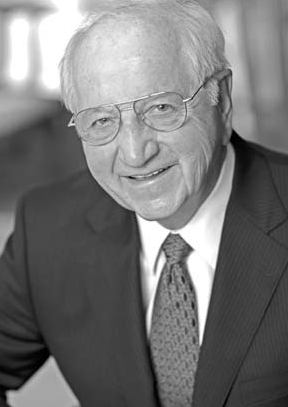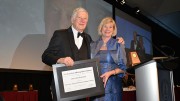The Canadian Mining Hall of Fame, of which The Northern Miner is a co-sponsor, will honour three new inductees at its 23rd annual dinner and induction ceremony on Jan. 13, 2011, at the Fairmont Royal York Hotel in Toronto. The new inductees are Mike Muzylowski, Bert Wasmund and John Williamson. For tickets and more information visit www.mininghalloffame.ca.
Mike Muzylowski (b. 1934)
During a distinguished career spanning more than a half-century, Mike Muzylowski contributed to the growth of Canada’s mining industry as a gifted geologist and mine-finder, innovative financier and respected senior mining executive. His diverse talents were instrumental in the discovery and development of 16 deposits that became producing mines — 13 in Manitoba, two in Nevada and one in the Northwest Territories — and the building of numerous mining companies, notably Granges Inc. and its subsidiary, Hycroft Resources and Development. With long-time partner Douglas McRae, he helped to open the doors to European and other foreign financial centres and establish the credibility of foreign investment in Canadian mineral exploration.
Muzylowski left the family farm near Oakburn, Man., to attend the University of Manitoba, where he earned a B. Sc. degree in geology. In 1955, he joined Hudson Bay Exploration and Development Co. (Hud- Bay) and spent five years as a field geologist before advancing to senior positions, including senior project geologist, chief geophysicist and assistant superintendent of exploration and development. Several of his Manitoba drill targets became HudBay producers, notably the Anderson Lake mine in the Snow Lake camp and the Centennial mine near Flin Flon.
In 1970, Muzylowski was recruited by the Swedish parent of Granges Exploration, Aktiebolag, to manage its North American exploration efforts. A few years later, he commissioned an airborne geophysical survey that revealed anomalies beneath Trout Lake, near Flin Flon. Subsequent drilling confirmed a copper-zinc deposit with associated precious metal that became the prolific Trout Lake mine.
In 1984, he accepted the post of president and CEO of Granges Exploration Ltd. after financier Doug McRae negotiated a deal to buy the company from its Swedish parent. The two formed an enduring and productive partnership and built Granges into a mid-tier producer with revenues that grew from $4 million to $65 million (the company was acquired by Australian mining giant MIM in 1989). In addition to the cornerstone Trout Lake mine, Granges explored and developed other deposits in Manitoba, including two gold-silver deposits that later became the Puffy Lake and Tartan Lake mines. Muzylowski and McRae also built Hycroft into a profitable producer after developing the Crofoot and Lewis gold mines in Nevada. The dynamic duo was among the first to access capital in foreign financial centres, raising a total of $400 million for Granges and Hycroft during the 1980s, and paving the way for other Canadian companies to attract foreign investment capital.
For these and other achievements, Muzylowski was honoured as “Developer of the Year” in 1988 by the Prospectors and Developers Association of Canada. He has since contributed to the growth of other companies, notably Winspear Resources and DRC Resources (predecessor to New Gold Inc.). His faith in Manitoba’s mineral potential continues in his present capacity as president of Callinan Mines, which holds royalty and net profit interests in the 777 copper-zinc mine in Flin Flon.
Bert Wasmund (b. 1939)
Bert Wasmund has been a world-renowned leader in metallurgical plant engineering and design for more than 40 years, as well as a driving force in the growth and success of Hatch Ltd., a Canadian firm serving the global mining and metallurgical industry. He is credited with a series of breakthrough contributions to metallurgical operations in Canada and abroad that improved their productivity, cost and energy efficiencies, their capability to extract valuable products from lower-grade ores and environmental performance in many cases. He has demonstrated a lifelong commitment to the acquisition and mentor-ship of the next generation of engineers.
This leadership has helped to attract a new generation to the mining and metallurgical industry and provided young professionals with interesting and challenging careers.
Wasmund was born in Monteagle, Ont., and earned B. Sc. and M. Sc. degrees in chemical engineering from Queen’s University in 1961 and 1963, respectively, and a PhD in chemical engineering, from the University of Toronto in 1966. He then joined Hatch Ltd., a pioneer company with a staff of 40, where he became known for his technical skills and innovative approach to metallurgical and mineral processing challenges. Most noteworthy was his 1973 invention of technology for cooling the walls of smelting furnaces using solid copper elements, which enhanced the productivity, lifespan and energy efficiency of smelters used in metals extraction, particularly nickel, precious metals and other complex ores. This patented technology was first used by Falconbridge (now Xstrata) at its Falcondo nickel-smelting complex in the Dominican Republic, and later became the cornerstone of Hatch’s thriving custom- design furnace business, with more than 100 installations worldwide.
In 1989, Wasmund and the Hatch team revolutionized the platinum smelting business with the design of a new electric smelting furnace for Impala Platinum in South Africa, which tripled daily production and reduced energy requirements by 25%. This remarkable achievement led to the development of many new plants in Canada and other parts of the world, and also earned Wasmund the 1994 Falconbridge Innovation Award of the Canadian Institute of Mining, Metallurgy and Petroleum and its prestigious Airey Award in 1998.
His contributions to the environmental progress of Canada’s mining and metals industry are among his finest achievements, notably in Ontario’s Sudbury nickel district, where he was a leader in sulphur dioxide abatement programs for nickel producers Falconbridge and Inco (now Vale) in the 1970s. Collaborating with the Hatch design team, he replaced outdated blast furnaces with a new smelting process using fluid-bed roasters and electric furnaces, and thereby dramatically improving air quality and the surrounding environment and greatly minimizing the vexing problem of acid rain. Other Canadian smelting complexes followed this strategy with great success.
Today, Wasmund continues to mentor scientists and engineers focused on solving major industrial challenges, including the development of renewable energy sources for future generations.
John T. Williamson (1907-1958)
Canada’s recent emergence as a centre of excellence for diamond exploration and production owes much to the pioneering efforts of John Williamson, a brilliant geologist from McGill University who discovered, built and operated the highly successful Williamson diamond mine — also known as Mwadui — in Tanganyika (now Tanzania). His efforts to build and operate a diamond mine in remote East Africa, where he spent much of his life from the mid-1930s until his death, are legendary. The mine’s total production from 1941-2008 has been estimated at 20 million carats, with a current value estimated at $3 billion. The mine created thousands of jobs and a socially progressive town-site known for its amenities. Williamson also left a valuable legacy in Canada, by recruiting and introducing young scientists, notably McGill graduates, to the newly emerging diamond industry. Decades later, they lent their expertise and credibility to help Canada realize its diamond potential.
Born in Montfort, Que., Williamson entered Montreal’s Mc- Gill University in 1925, intending to study law, but a summer field expedition to Labrador inspired him to switch to geology. He earned his BA, M. Sc. and PhD degrees in geology between 1928 and 1933.
After visiting Africa for the first time, he accepted a position with Anglo American in the copper belt, but resigned in 1936 to pursue a newfound interest in diamonds. He then joined junior company Tanganyika Gold and Diamonds Ltd. and carried out a diamond prospecting campaign until the company left Tanganyika in 1939. Williamson stayed behind to continue the hunt through his own private company, Williamson Diamonds Ltd. It was a bold move, as he had few resources other than fierce determination and a theory that systematic prospecting of dolerite dykes associated with kimberlite fields would lead to the discovery of diamond indicator minerals and, ultimately, diamonds.
Williamson was down to his last penny and battling bouts of malaria before his hard work paid off with the discovery of a single diamond in an isolated region called Mwadui. Remarkably, he built his discovery into a mine on his own as well, by selling diamonds as they were mined to buy equipment and finance operations. Fortunately, the mine produced many fine gems, including a pink 54-carat rough diamond presented to Princess Elizabeth and Prince Philip on their wedding day in 1947. By 1952, the mine was operating at 10,000 tons per day, with the biggest dragline and longest conveyor belt in Africa. Mwadui was a mining town without equal at the time, built for miners and their families with amenities such as schools, hospital and recreational facilities.
The mine was also a training ground for many young scientists. Williamson relied heavily on Canadian talent to transform his discovery into one of the world’s largest diamond mines. Fortunately for Canada, many of them later returned home to train, mentor and inspire a new generation of diamond industry professionals.






Be the first to comment on "Three legends to join the Canadian Mining Hall of Fame"